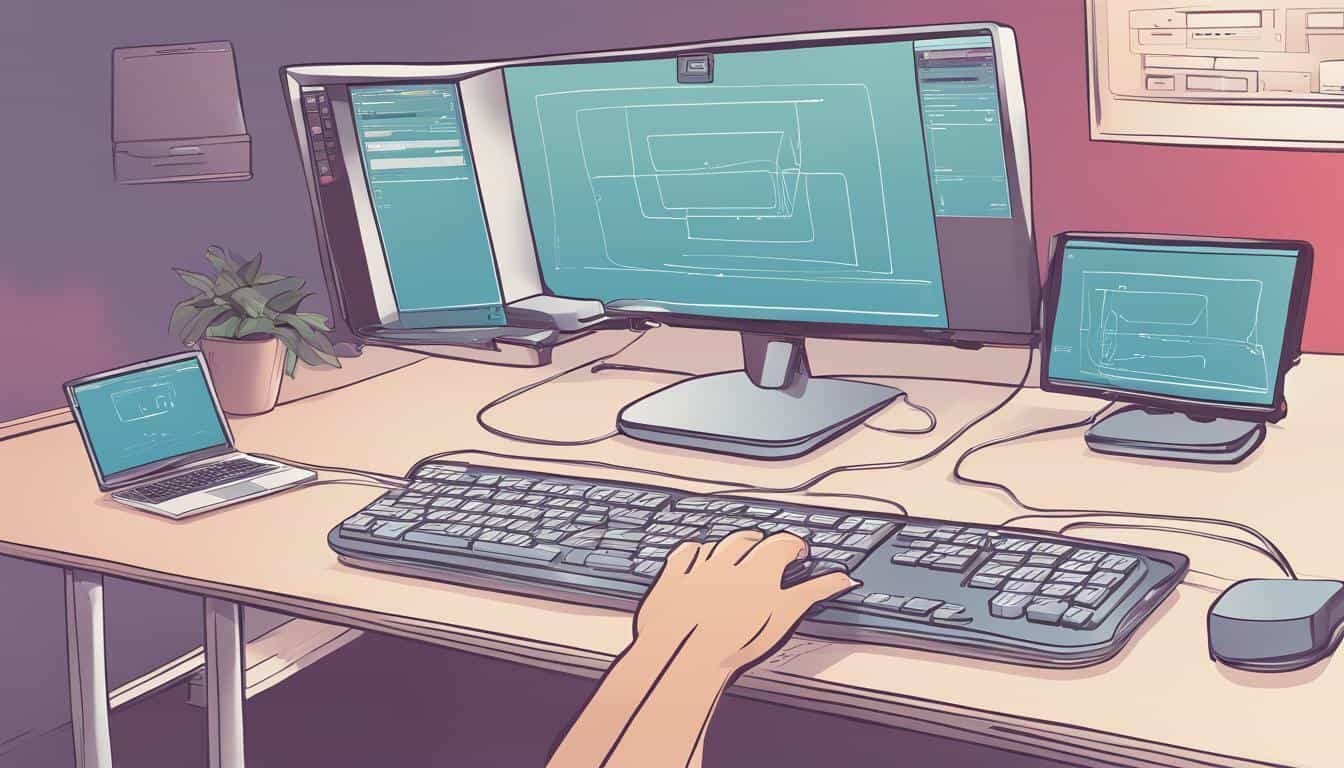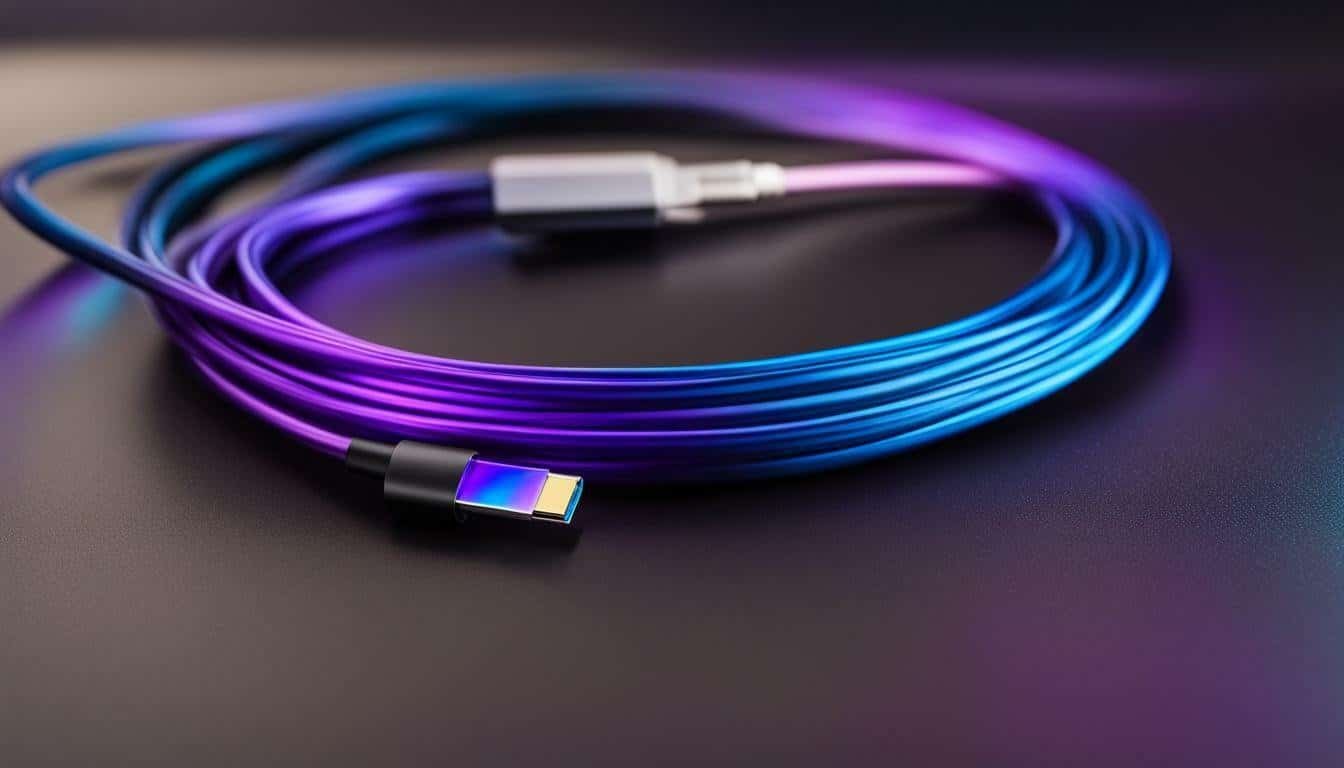As a professional in the tech industry, I frequently come across the term “KVM switch”. KVM stands for “keyboard, video, and mouse”, and a KVM switch is a device that allows you to control multiple computers or servers using a single set of peripherals. In other words, you can use one keyboard, mouse, and monitor to switch between two or more computers.
The benefits of using a KVM switch are numerous, including increased productivity, reduced clutter, and easier management of multiple computers. But how does a KVM switch work, and what are the different types available on the market? In this article, we will explore the ins and outs of KVM switches, from their functions to their setup and future trends.
Key Takeaways:
- A KVM switch is a device that allows you to control multiple computers using a single set of peripherals.
- Using a KVM switch can increase productivity, reduce clutter, and simplify computer management.
- In this article, we will explore the functions, benefits, types, setup, key features, case studies, and future trends of KVM switches.
How Does a KVM Switch Work?
In order to understand how a KVM switch works, it is important to first understand the function of a KVM switch. A KVM switch, which stands for keyboard, video, and mouse switch, allows you to connect multiple computers to a single set of peripherals.
With a KVM switch, you can easily switch between the connected computers without having to physically disconnect and reconnect the peripherals to each computer. This is especially useful in situations where you need to use multiple computers but only have one set of peripherals.
The KVM switch acts as a mediator between the connected computers and the peripherals. When you switch between computers, the KVM switch sends the input signals from the peripherals to the selected computer and sends the output signals from the computer to the peripherals.
Most KVM switches use a simple button or key combination to switch between computers. Some more advanced models may have additional features such as hotkey switching or the ability to switch between computers automatically based on certain conditions.
Benefits of Using a KVM Switch
Using a KVM switch can provide several benefits for businesses and individuals. Here are some of the most significant advantages:
| Benefit | Description |
|---|---|
| Space-saving | A KVM switch enables you to control multiple computers with a single keyboard, mouse, and monitor, reducing the need for additional desk space and equipment. |
| Cost-effective | Instead of having to purchase multiple sets of peripherals for each computer, a KVM switch allows you to share a single set across multiple machines, reducing overall costs. |
| Time-saving | A KVM switch allows you to switch between computers with ease, reducing the need to physically move between machines and saving time in the process. |
| Enhanced productivity | By allowing you to control multiple computers with a single set of peripherals, a KVM switch can help to improve your workflow and increase productivity. |
| Flexibility | A KVM switch enables you to switch between computers regardless of their operating system or platform, providing a great deal of flexibility and convenience. |
Other Benefits
In addition to the above advantages, KVM switches offer several other benefits, such as increased security and reduced clutter. By centralizing control over multiple machines, a KVM switch can also help to reduce the risk of data breaches and other security issues.
When selecting a KVM switch, it’s essential to consider your specific needs and requirements to ensure that you choose the right device for your setup. By doing so, you can effectively leverage the benefits of a KVM switch and improve your workflow and productivity.
Types of KVM Switches
There are several types of KVM switches available on the market, each designed to meet specific needs and requirements. Choosing the right type of KVM switch depends on the number of computers you need to control, the type of peripherals you’re using, and the distance between the switch and the computers.
Desktop KVM Switches
Desktop KVM switches are designed for use in small offices or home offices. They usually support between two and four computers and are compact, making them ideal for use in limited desk spaces. Desktop KVM switches typically come with built-in cables, making them easy to set up and use.
Rackmount KVM Switches
Rackmount KVM switches are designed for use in server rooms and data centers. They support multiple computers, ranging from eight to sixty-four, and are mounted on a rack, making them easy to manage. Rackmount KVM switches usually come with removable cables, allowing for easy replacement and maintenance.
IP KVM Switches
IP KVM switches allow remote access and control of computers over the internet or a network. They support multiple computers and enable remote management and control, making them ideal for use in large organizations with multiple locations. IP KVM switches typically require additional software to enable remote access and control.
Wireless KVM Switches
Wireless KVM switches use radio frequency technology to connect computers and peripherals without the need for cables. They’re ideal for use in conference rooms, presentations, and other situations where cables can be inconvenient. Wireless KVM switches typically have a limited range and may experience interference from other devices.
Selecting the Right KVM Switch
When it comes to selecting the right KVM switch, there are a few factors to consider to ensure you get the best device for your needs. Here are some key things to keep in mind:
Number of Computers to Control
The first thing to consider is how many computers you need to control with the KVM switch. Determine the number of computers you will be using and make sure the switch can accommodate that amount. Keep in mind, some switches can handle more devices than others.
Types of Computers
Consider the types of computers you will be connecting to the switch. Different KVM switches offer compatibility with specific types of computers, so be sure to choose a switch that supports your computer’s model and operating system.
Remote Access Needs
Consider whether you need remote access to your computers. Some KVM switches offer remote access capabilities, allowing you to control your computers from anywhere with an internet connection.
Additional Features
Finally, consider any additional features you may need, such as audio support, USB ports, or dual monitor support. Some KVM switches offer a variety of features to enhance your experience.
By taking these factors into account, you can select the best KVM switch for your needs and enjoy smoother and more efficient computer management.
KVM Switch Setup Guide
Setting up a KVM switch is a straightforward process that can be completed quickly and easily. Here are the steps you need to follow to get started:
- Ensure that all devices to be connected to the KVM switch are turned off and unplugged.
- Connect each device’s keyboard, video, and mouse cables to the corresponding ports on the KVM switch.
- Connect the KVM switch to each device using the appropriate cables. Make sure the cables are securely connected.
- Connect the KVM switch to a power outlet and turn it on.
- Turn on each device one by one. The KVM switch will recognize each device automatically.
- Use the KVM switch’s hotkeys or on-screen display to switch between devices.
That’s it! Your KVM switch is now set up and ready to use. If you experience any issues, consult the user manual that came with your KVM switch for troubleshooting advice.
Key Features to Look for in a KVM Switch
When selecting a KVM switch, there are several key features to consider that can greatly impact its functionality and performance. Here are some of the most important features to look for:
| Feature | Description |
|---|---|
| Number of Ports | Make sure the switch has enough ports to accommodate all of the devices you need to connect. |
| Video Resolution | Check that the switch supports the resolution of your monitors to ensure clear and crisp image quality. |
| Hotkey Functionality | Look for a switch that allows you to quickly switch between devices using keyboard shortcuts. |
| Compatibility | Ensure the switch is compatible with the operating system and devices you intend to use it with. |
| USB Hub | A built-in USB hub can be convenient for connecting peripherals such as printers and scanners. |
| Audio Support | If audio is important for your setup, check that the switch supports it. |
Considering these key features when selecting a KVM switch can help you better narrow down your options and find the best switch for your needs.
Case Studies: Real-World Examples of KVM Switch Usage
Companies across various industries have realized the benefits of using KVM switches to optimize their IT operations. Let’s take a look at some of the real-world examples of KVM switch usage:
Case Study 1: Healthcare Industry
A large healthcare organization used a KVM switch to manage multiple computer systems, each with specific functions, while keeping the data secure. With a KVM switch in place, switching between systems became seamless, resulting in improved productivity. The organization was also able to reduce the number of IT support personnel needed, leading to cost savings.
Case Study 2: Finance Industry
A financial institution used a KVM switch to manage multiple trading stations, each with their own set of monitors and keyboard/mouse. The KVM switch allowed traders to switch between stations with ease, resulting in significant time savings. The KVM switch also helped to reduce clutter on the trading floor, making it more organized and efficient.
Case Study 3: Education Industry
A university implemented a KVM switch to manage multiple computer systems in its computer lab. With a KVM switch in place, the lab administrator was able to manage the computers remotely, reducing the need for on-site IT support. The KVM switch also helped to save space by reducing the number of keyboards, mice, and monitors needed for the lab.
These case studies demonstrate the versatility and effectiveness of KVM switches across various industries. When selecting a KVM switch, it’s important to consider your specific needs and the environment in which it will be used.
Future Trends in KVM Switch Technology
As technology continues to advance and workplaces evolve, the demand for more efficient and streamlined processes increases. KVM switch technology is no exception to this trend, and there are several exciting developments on the horizon.
1. Cloud-Based KVM Switches
One significant trend in KVM switch technology is the move towards cloud-based solutions. This has several benefits, including centralized management, easy scalability, and increased security. With cloud-based KVM switches, companies can access their devices from anywhere with an internet connection, making remote work and collaboration more accessible than ever before.
2. Wireless KVM Switches
Another exciting development in KVM switch technology is the emergence of wireless solutions. These devices eliminate the need for cables, allowing for greater flexibility and convenience. This is particularly useful in situations where space is limited or where devices need to be relocated frequently.
3. Integration with Virtual Reality and Augmented Reality
With the increasing popularity of virtual and augmented reality technologies, it’s no surprise that KVM switches are being developed to integrate with these platforms. These devices allow users to control virtual and augmented reality environments using their existing keyboard, mouse, and monitor, making these technologies more accessible and user-friendly.
4. Enhanced Security Features
As cybersecurity threats continue to evolve and become more sophisticated, KVM switch manufacturers are responding by enhancing their devices’ security features. This includes advanced encryption protocols, user authentication, and secure remote access. With these features, companies can rest assured that their devices and data are safe from cyber-attacks.
In conclusion, the future of KVM switch technology is bright, with several exciting developments on the horizon. From cloud-based solutions and wireless devices to integration with virtual and augmented realities and enhanced security features, KVM switches are becoming more efficient, versatile, and accessible than ever before.
Conclusion
In conclusion, investing in a KVM switch can greatly enhance your computing experience. Not only does it save space and reduce clutter, but it also allows for seamless switching between multiple devices. As technology continues to evolve, we can expect to see even more advanced KVM switch options in the future.
When selecting a KVM switch, it is important to consider factors such as the number of devices you will need to connect, the types of devices, and the specific features you require. By doing so, you can ensure that you choose the best KVM switch for your needs.
Overall, a KVM switch is a powerful tool that can increase productivity, streamline workflows, and improve overall performance. Whether you are a professional or a casual user, a KVM switch is a worthwhile investment.
How Can a KVM Switch Simplify My Workspace?
A KVM switch can simplify your workspace by minimizing clutter and maximizing efficiency. With a single KVM switch, you can control multiple computers using a single keyboard, monitor, and mouse. This means no more tangled cables or multiple keyboards and mice cluttering up your desk. Simplify your workspace with kvm switches for a streamlined and organized setup.
FAQ
Q: What is a KVM Switch?
A: A KVM switch, short for Keyboard, Video, and Mouse switch, is a hardware device that allows you to control multiple computers using a single set of peripherals. It eliminates the need for separate keyboards, mice, and monitors for each computer, making it more convenient and efficient to manage multiple systems.
Q: How does a KVM Switch Work?
A: A KVM switch works by connecting the keyboards, monitors, and mice of multiple computers to a central switch. With the press of a button or through hotkey commands, you can switch control between the connected computers. The KVM switch acts as a mediator, allowing you to operate the different systems seamlessly.
Q: What are the Benefits of Using a KVM Switch?
A: Using a KVM switch offers several benefits, including saving space and reducing clutter by consolidating peripherals, improving productivity by providing quick and easy access to multiple computers, and enhancing data security by isolating sensitive systems from external networks.
Q: What are the Types of KVM Switches?
A: There are different types of KVM switches available, including desktop KVM switches, rack-mountable KVM switches, and IP-based KVM switches. Desktop switches are compact and ideal for small-scale setups, while rack-mountable switches are designed for server rooms and data centers. IP-based switches enable remote access to computers over the internet.
Q: How to Select the Right KVM Switch?
A: Selecting the right KVM switch involves considering factors such as the number of computers you want to control, the type of peripherals you need to connect, the distance between the switch and the computers, and any specific features or functionalities required for your setup. It is important to choose a KVM switch that meets your specific needs.
Q: How to Set Up a KVM Switch?
A: Setting up a KVM switch involves connecting the peripherals and computers to the switch using the appropriate cables and ports. Once connected, you can use the switch’s controls or hotkey commands to switch between computers. It is important to follow the manufacturer’s instructions for proper installation and configuration.
Q: What are the Key Features to Look for in a KVM Switch?
A: When choosing a KVM switch, key features to consider include the number of ports, video resolution support, USB or PS/2 compatibility, hotkey support, and any additional functionalities or advanced capabilities that are important for your specific requirements.
Q: Are There Case Studies of Real-World Examples of KVM Switch Usage?
A: Yes, there are case studies available that showcase real-world examples of how organizations have successfully utilized KVM switches to streamline their operations, improve efficiency, and enhance their IT infrastructure. These case studies provide valuable insights into the practical applications and benefits of KVM switches in various industries.
Q: What are the Future Trends in KVM Switch Technology?
A: The future of KVM switch technology is expected to focus on advancements such as increased compatibility with emerging hardware and software technologies, improved remote access capabilities, enhanced security features, and greater flexibility in terms of device connectivity and integration.

![Top & Best Processors For Hacking: [High-Performance CPUs]](https://nondevelopers.com/wp-content/uploads/2023/06/Best-Processors-for-hacking.jpg)


0 Comments